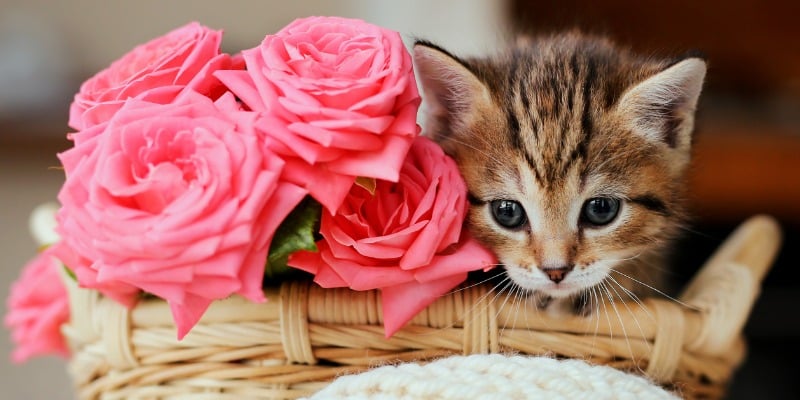
Flowers and pets are both charming to share your home with, but they don’t always mix!
To help you get the best of both worlds we’ve put together this guide for you. When keeping a plant in your home it is important that all parts of the plant are safe for your pet. This guide will walk you through choosing the safest options: from the pollen a flower may drop, right down to the roots and leaves of a house plant.
We will first we will be covering a range of pet friendly flowers. We’ll specifically look at which flowers are safe for cats and which flowers are safe for dogs. We will then look in depth at what flowers are poisonous to cats and what flowers are poisonous to dogs.
If you are reading this there’s a likelihood you’ve been gifted a bouquet and want some answers fast. To save you time we’ve got a handy contents list below so you can jump straight to the info you need. If you are reading this because your pet has eaten something they shouldn’t have please contact your vet. You check our list of symptoms below or look specifically for plants poisonous to cats or plants poisonous to dogs.
Contents
- Which flowers & plants are safe for pets?
- Grasses
- Herbs
- Palms
- Pet Friendly Flowers & Plants
- Pet Friendly Cut Flowers
- Pet Friendly House & Garden Plants
- Which flowers and plants are poisonous to cats?
- Signs of Plant & Flower Poisoning in Cats
- Cut Flowers That Are Toxic for Cats
- Lilies & Cats
- House Plants That Are Toxic for Cats
- Which flowers and plants are poisonous to dogs?
- Signs of Plant Poisoning In Dogs
- Cut Flowers That Are Toxic for Dogs
- House Plants That Are Toxic for Dogs
Which Flowers and Plants Are Safe For Pets?
There are a wide range of plants and flowers that are safe for pets. However, always remember that any plant, even ‘safe’ ones, that are rotting or mouldy can also be unsafe for your pet to ingest as it can disrupt their digestive tract. With all plants in your home it is important to keep a good eye on them and prune away any rotting leaves.
Similarly, eating too much of even a safe plant can cause your pet to vomit. Here, we have covered flowers safe for both cats and dogs. When considering what plants are safe for either specifically, there are a few considerations.
As hunters and pouncers, cats will need any low, sturdy protrusions to be pruned off if your cat is collared to ensure they don't get caught on them. Dogs can be a risk to gardens, which becomes a risk to them. Consider planting robust plants and sturdier perennials. Arrange your garden to allow you to use stockier shrubs as a support to other flowers.
In your house, try to keep plants out of your pet's way where possible - even safe plants can end up nibbled or knocked over by an enthusiastic cat or dog!
The wide range of flowers that are perfectly healthy for both cats and dogs is unsurprising when we consider that many flowers are also safe for human consumption: think sunflowers, roses and violets. Browse our complete list of safe plants below and you will see many familiar garden and bouquet favourites. We’ve also covered the safety of some families of plants that are common to find around your home and garden.
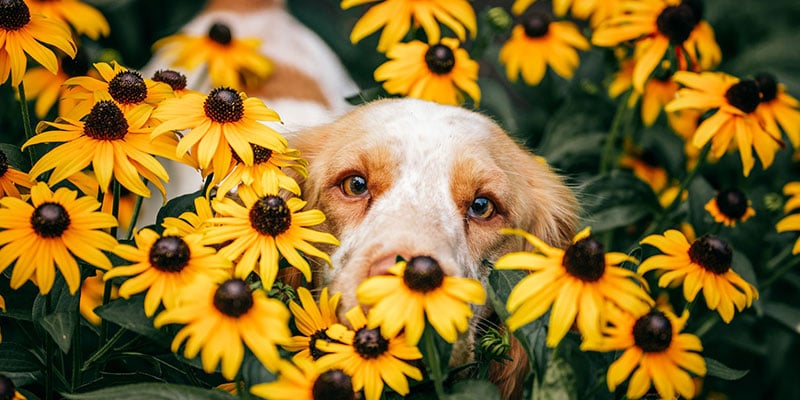
Grasses
Not a traditional flower, but many types of grass flower throughout the year if left to seed. The grass family is almost all safe for pets, and we have listed the exceptions below. Many of us have cats or dogs that will eat grass. As long as it has no pesticides or other chemicals on, grass is perfectly safe for both dogs and cats to eat. They will still be sick if they eat too much of it. If you are worried your pet is eating too much grass, it is still worth contacting a vet as this may be a sign of another problem.
There are several theories as to why they do this, but no conclusive reason. Both dogs and cats gain mental stimulation from eating grass, so if you want them to cut down it can be a good idea to get them a range of toys to play with instead. Cats will be actively tempted into eating grass that you have in your home and garden. If you are going to have grasses around your home, please be aware they may get nibbled. Once a cat becomes accustomed to eating plants around your home they will be tempted to eat whatever they can find, so be extra careful to have removed all toxic plants.
Cereal grains and grasses create good coverage and are excellent for boosting native insect and pollinator populations in your gardens. Lucerne, also known as alfalfa, has pretty purple flowers and is especially popular for this purpose. If you want to plant a particularly unusual and ornamental species of grass it is worth checking the genus specifically.
Herbs
Similar to flowers, many herbs are safe for you and safe for your pets! Dogs especially enjoy the array of smells a herb garden provides, and planting across various heights can provide even more mental stimulation. The one herb to be very careful of is mint, which is toxic to cats.
Palms
Palms have many of the positive qualities of grasses for pets. They’re engaging and provide stimulation both in the plant itself and the shadows they cast. An advantage over grasses is the great ease with which they can fit into an interior design scheme.
Most true palms are completely safe for pets, but there are some exceptions. Fishtail palms (Caryotas) are not safe for dogs or cats. Sago palms are not actually palms (they're cycads), and can be very toxic to both dogs and cats.
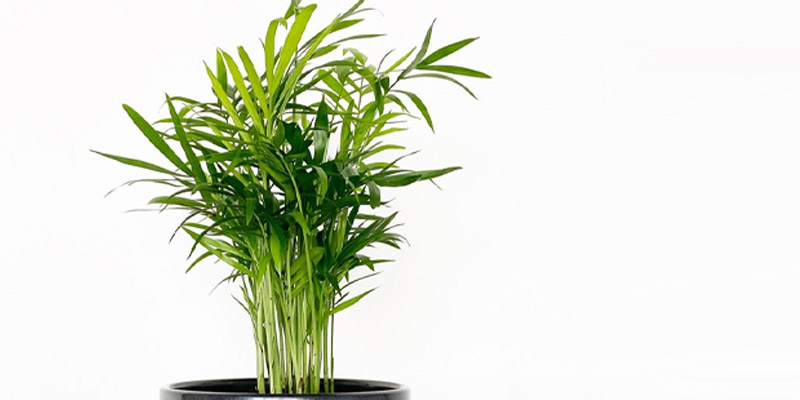
Pet Friendly Flowers & Plants
Take a look at some of our favourite pet-friendly plants and cut flowers in our list below. All of these have been reported non-toxic for cats and dogs, but we always recommend keeping house plants and bouquets out of the reach of animals regardless (mostly so they don't get knocked over!)
Pet Friendly Cut Flowers
All of the cut flowers below are ideal if you're looking for a lovely pet friendly bouquet.
|
Astilbe |
Cornflower |
|||
|
Greenbell |
Lilac |
|||
|
Limonium |
Lisianthus |
|||
|
Phlox |
Pittosporum |
|||
|
Salix (Pussy Willow) |
Scabiosa |
Snapdragons |
||
|
Statice |
Stocks |
|||
|
Veronica |
Waxflowers |
|||
Pet Friendly House & Garden Plants
Make your house and garden safe for your pets with this selection of pet safe house plants, garden plants, herbs, and vegetables. Don't forget that eating too much of any plant can cause an upset tummy, so we do recommend keeping house plants out of the reach of pets where possible.
| African Daisies | African Violets | Air Plants | ||
| Areca Palm | Bamboo | Basil | ||
| Beetroot | Bird’s Nest Fern | Blue Star Fern | ||
| Burro's Tail | ||||
| Button Fern | Calatheas | Calendula (Pot Marigold) | ||
| California Pitcher Plant | Camellia | Carrot | ||
| Celery | Chicory | Coriander | ||
| Cosmos | Dill | Dogwood | ||
| Echeveria | Fennel | |||
| Fuchsia | Heather (Ling) | Ice Plants | ||
| Jasmine (Jasminium) | Kentia Palm | Lipstick Plant | ||
| Magnolia | Maidenhair Fern | Money Tree | ||
| Nasturtium | ||||
| Petunias | Pineapple Plant | |||
| Ponytail Palm | Sage | |||
| Squashes | Strawberries | |||
| Violet | Zebra Haworthia | Zinnia | ||
Which Flowers & Plants are Poisonous to Cats?
You know your pet best, if they are not acting themselves there might be something wrong with them. Plant poisoning can often accelerate quickly, and identifying the symptoms as early as possible is incredibly important for the welfare of your pet.
Signs of Plant & Flower Poisoning in Cats
Cats can often become reticent when poorly, so it important to know the signs of plant poisoning ahead of time so that you can best keep them safe. Symptoms of plant poisoning in cats include:
- Stomach upset- vomiting, diarrhoea and avoiding eating are all signs of something wrong.
- Low energy or disinterest in usual activities
- Pale gums or ulcers in mouth
- Drooling
- Drinking or urinating more than usual
- Rashes or inflamed skin
- Twitching, seizure or collapse
As natural explorers, cats may also get the sap, resin or pollen of poisonous plants stuck to their fur while out adventuring. This can damage their skin when they try and groom stubborn residue off of themselves. This can cause further issues if ingested. If your cat explores outdoors it is recommended to check them over while fussing them in case they have gotten anything stuck in their fur.
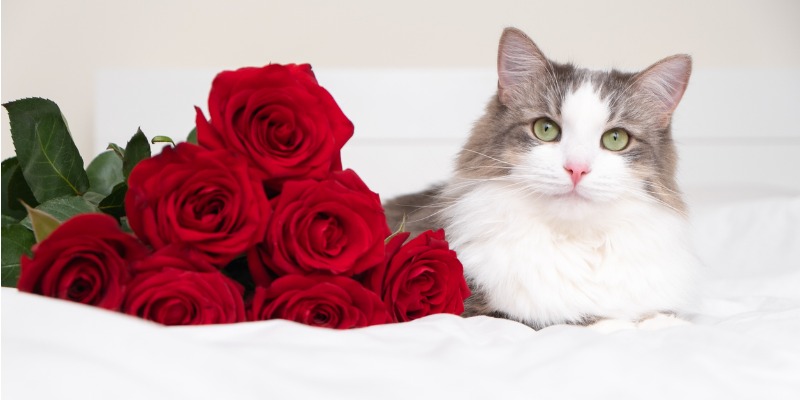
Cut Flowers That Are Toxic for Cats
Bouquets with the following flowers should be kept well out of the reach of cats. We strongly recommend that lilies, ornithogalum, and lilies of the valley are not bought at all for cat owners.
Most other varieties in this list are not as toxic but can still cause issues such as stomach upset and skin irritation depending on how much is eaten, so we recommend keeping them out of your cat's reach.
| Allium | Alstroemeria | Amaryllis | ||
| Ammi | Anemone | Asparagus Fern | ||
| Bupleurum | Calla Lily | Carnation | ||
| Chrysanthemum | Clematis | Craspedia | ||
| Daffodil | Dahlia | Delphinium | ||
| Eucalyptus | Gladiolus | Gypsophila (Baby's Breath) | ||
| Hyacinth | Hydrangea | Hypericum | ||
| Iris | Lavender | Lilies | ||
| Lily of the Valley | Ornithogalum | Peony | ||
| Poppy | Ranunculus | Ruscus | ||
| Salal | Senecio | September Flower | ||
| Sweet Pea | Sweet William | Tanacetum | ||
Lilies & Cats
Probably the most famously toxic plants for pets, lilies are very dangerous for cats, and all parts of the plant are highly poisonous to cats. They drop pollen that is highly toxic to cats so should not be kept in the same space as a cat, even if out of reach. If they brush against the plant and get pollen caught in their fur, they may lick it off themselves when grooming and be poisoned.
All lilies in the lilium family are toxic. This includes Stargazer lilies, Easter lilies, Asiastic lilies, oriental lilies, and many other types common in flower bouquets. Calla lilies are not a true lily - they are not as dangerous, but can still have some adverse effects so we recommend keeping them out of the reach of cats.
If suspected, contact your vet immediately about lily poisoning. Watch out for vomiting, low energy and excessive drinking in particular.
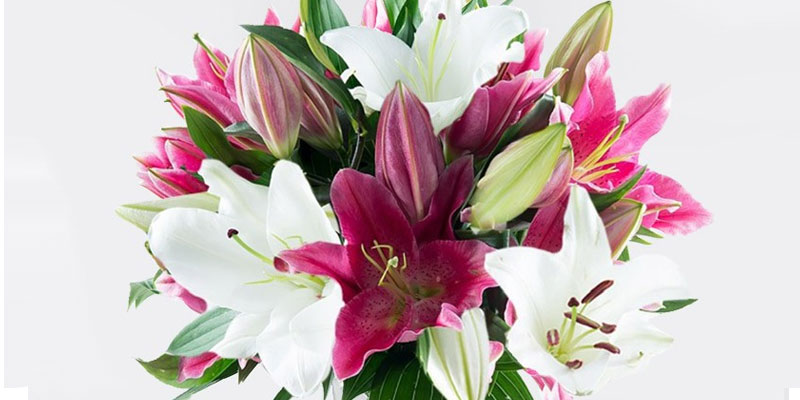
House Plants That Are Toxic for Cats
We've put together of some common house plants that can be poisonous to cats. We always recommend researching any plant before buying if you have pets.
| Alocasia | Aloe Vera | Anthurium | ||
| Asparagus Fern | Cordyline | Cycad Palm (Sago Palm) | ||
| Dieffenbachia (Dumb Cane) | Dracaena (Dragon Tree) | English Ivy | ||
| Euphorbia | Ficus Benjamina | Ficus Ginseng Bonsai | ||
| Fiddle Leaf Fig | Fishtail Palm | Jade Plant | ||
| Lily Plant | Monstera (Cheese Plants) | Peace Lily | ||
| Philodendron | Poinsettia | Pothos (Devil's Ivy) | ||
| Schefflera (Umbrella Plant) | Snake Plant (Sanseviera) | Tulip | ||
| Yucca | ZZ Plant |
Please note that although spider plants aren't toxic to cats, cats are often drawn to them as the plant has hallucinogenic effects on them (similar to catnip). You may wish to avoid them for this reason, as spider plants might struggle to survive in a house with a cat.
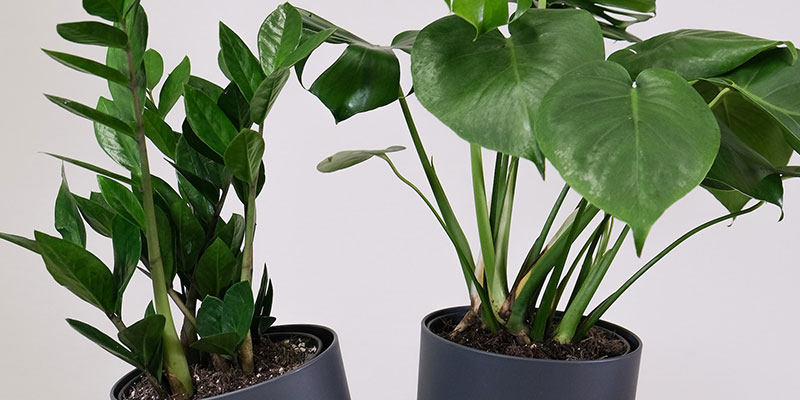
Which Flowers & Plants are Poisonous to Dogs?
There's a lot of overlap between flowers poisonous to cats and dogs, with the main difference often being how severe the effects can be. For example, whilst lilies can be deadly for cats, they'll usually cause no more than an upset tummy in dogs.
Signs of Flower & Plant Poisoning In Dogs
Symptoms are most obviously apparent in dogs mouths. Excessive drooling, vomiting or increased redness are often the first signs of poisoning. Many dogs will also experience delayed emotional effects, such as increased anxiety or startling more easily. Symptoms of plant poisoning in dogs include:
- Drooling
- Redness, sores or irritation in mouth
- Vomiting or diarrhoea
- Tremors
- Pain and expressions of this such as unexpected yelping and whining
- Difficulty breathing and swallowing
- Seizures
- Heart rhythm abnormalities, and potentially heart failure
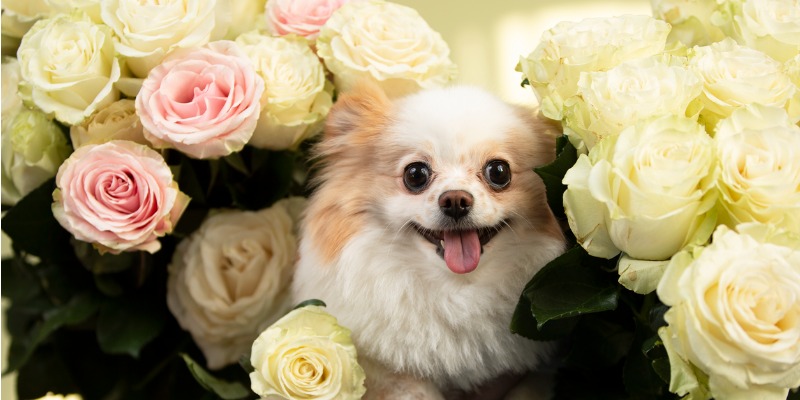
Cut Flowers That Are Toxic for Dogs
We recommend keeping bouquets containing any of the stems below well out of the reach of your dog.
| Amaryllis | Anemone | Asparagus Fern | ||
| Bupleurum | Calla Lily | Chrysanthemum | ||
| Clematis | Craspedia | Daffodils | ||
| Delphinium | Eucalyptus | Gardenia | ||
| Gladiolus | Goldenrod (Solidago) | Gypsophila (Baby's Breath) | ||
| Hyacinth | Hydrangea | Gypsophila (Baby's Breath) | ||
| Hyacinth | Hydrangea | Iris | ||
| Lavender | Lily | Lily of the Valley | ||
| Ornithogalum | Pampas Grass | Peony | ||
| Poppy | Ranunculus | Ruscus | ||
| Senecio | September Flower | Sweet Pea | ||
| Sweet William | Tulip | |||
House Plants That Are Toxic for Dogs
Here are some common house plants you should make sure your dog can't get to. Hanging baskets are a great way to keep plants out of your dog's reach! If you can't see a plant on the list below, make sure to double check before buying.
| Alocasia | Aloe Vera | Anthurium | ||
| Asparagus Fern | Cordyline | Cycad Palm (Sago Palm) | ||
| Dieffenbachia (Dumb Cane) | Dracaena (Dragon Tree) | English Ivy | ||
| Euphorbia | Ficus Benjamina | Ficus Ginseng Bonsai | ||
| Fiddle Leaf Fig | Fishtail Palm | Jade Plant | ||
| Lily Plant | Monstera (Cheese Plants) | Peace Lily | ||
| Philodendron | Poinsettia | Pothos (Devil's Ivy) | ||
| Schefflera (Umbrella Plant) | Snake Plant (Sanseviera) | Tulip | ||
| Yucca | ZZ Plant |
Looking for a beautiful bouquet or house plant that's safe for your pet too? Take a look at our range of pet friendly flowers and plants!
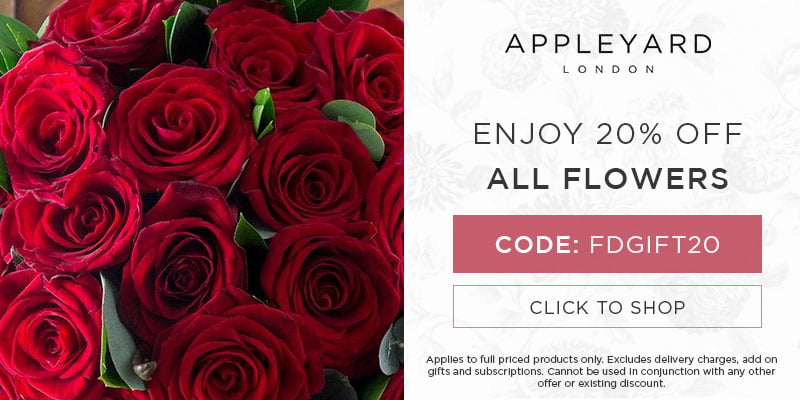

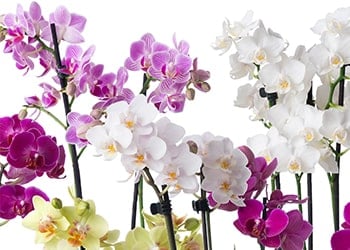
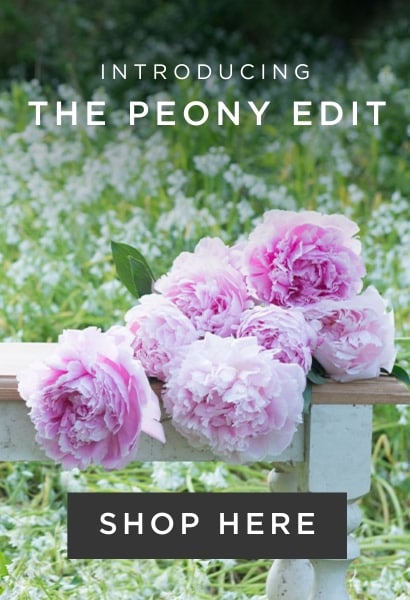
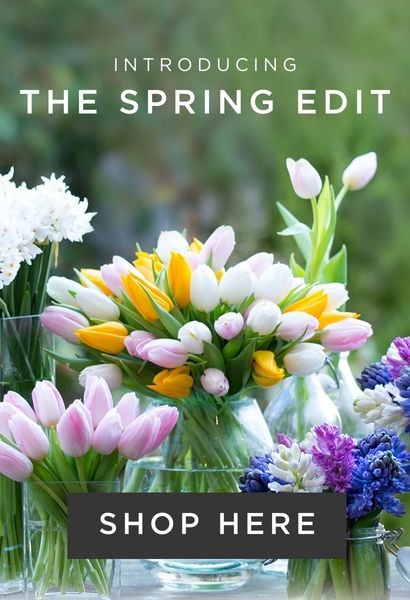


